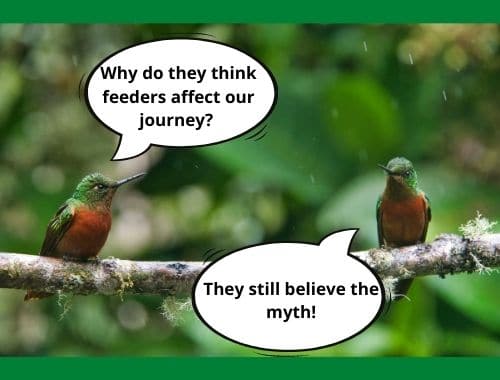Do you have this common question “When should I take down my hummingbird feeder”? Here is a dedicated article on this topic that helps you to understand when to stop feeding hummingbirds.
Let’s get started!
Myth!

There is a common myth among birders that “if they leave their feeders up at migration time then birds stick around and delay their migration.”
The simple answer is that it is not true. Hummingbirds migrate due to their internal biological calendar, innate and environmental cues. They start their embark south in search of warmer temperatures, insects and other food sources, and flowers.
Instead, Keeping your feeder is a good decision. The birds which are present in your local area all summer may have started their journey to the south. But, those who begin the journey from farther north may use your feeder for a quick pit stop on their way.
When should I take down my hummingbird feeder?
Do you still think that keeping feeder outside at migration time will cause the process to be delayed? I hope your answer is a big no.
It is a good decision to keep the feeders as long as hummingbirds visit the feeders instead. Offer nectar on your feeder at least two weeks after you see the last one. A straggler might come through and gather energy and fat for the long journey to the south.
Hummingbird season: When keeping off the feeders
The exact timing of the migration process varies by region and number of other factors. Here is a list of different states and when it is safe to take down the feeder.
| State | Common Species | Start Migration | Take Down The Feeder |
| Alabama | Rufous, Ruby-throated and Black-chinned | Early November | Late November |
| Alaska | Rufous | Late August | Mid-September |
| Arizona | Several Species | Late October | Never |
| Arkansas | Ruby-throated | Mid-November | Early December |
| California | Around 14 species | Late September | Never |
| Colorado | Rufous, Broad-tailed, and Black-chinned | Mid October | Early November |
| Connecticut | Rufous and Ruby-throated | Early October | Early November |
| Delaware | Ruby-throated and Rufous | Late October | Mid-November |
| Florida | Ruby-throated ( Stay All year) | Never | |
| Georgia | Rufous and Ruby-throated | Never | |
| Hawaii | N/A | N/A | N/A |
| Idaho | Rufous, Calliope, Broad-tailed, and Black-chinned | Late September | Early November |
| Illinois | Ruby-throated | Late October | Mid-November |
| Indiana | Ruby-throated | Late October | Mid-November |
| Iowa | Ruby-throated | Late October | Mid-November |
| Kansas | Ruby-throated and Rufous | Mid October | Early November |
| Kentucky | Rufous and Ruby-throated | Late November | Mid December |
| Louisiana | Several Species | Around November | Never |
| Maine | Ruby-throated | Late October | Mid-November |
| Maryland | Rufous and Ruby-throated | Late October | Never |
| Massachusetts | Ruby-throated | Late November | Mid December |
| Michigan | Ruby-throated | Mid October | Early November |
| Minnesota | Ruby-throated | Late November | Mid-November |
| Mississippi | Ruby-throated and few others | Late December | Never |
| Missouri | Ruby-throated | Late November | Mid December |
| Montana | Rufous, Black-chinned, Broad-tailed, Calliope and Ruby-throated | Late September | Mid October |
| Nebraska | Ruby-throated | Late October | Mid-November |
| Nevada | Broad-tailed, Rufous, Black-chinned, and Calliope | Mid-November | Never |
| New Hampshire | Ruby-throated | Mid October | Early November |
| New Jersey | Ruby-throated | Early November | Late November |
| New Mexico | Rufous, Broad-tailed, Black-chinned and Calliope | Late November | Never |
| New York | Ruby-throated | Mid-November | Early December |
| North Carolina | Ruby-throated | Mid-November | Early December |
| North Dakota | Ruby-Throated | Early October | Late October |
| Ohio | Ruby-throated | Mid-November | Early December |
| Oklahoma | Rufous, Black-chinned and Ruby-throated | Late October | Mid-November |
| Oregon | Black-chinned, Rufous and Calliope | Mid October | Mid-November |
| Pennsylvania | Ruby-throated | November | Never |
| Rhode Island | Ruby-throated | Early October | Late October |
| South Carolina | Ruby-throated and Rufous | Mid-November | Early or Mid December |
| South Dakota | Ruby-throated, Broad-tailed and Rufous | Mid October | Early November |
| Tennessee | Ruby-throated | Mid-November | Early December |
| Texas | Ruby-throated, Lucifer and Black-chinned | November and December | Never |
| Utah | Rufous, Calliope, Black-chinned and Broad-tailed | Between October and December | Mid-December or Never |
| Vermont | Ruby-throated | Late October | Mid-November |
| Virginia | Ruby-throated | Early December | Late December |
| Washington | Black-chinned, Calliope and Rufous | Late October | Mid-November |
| West Virginia | Ruby-throated and Rufous | Late October | Mid-November |
| Wisconsin | Ruby-throated | Late November | Mid December |
| Wyoming | Black-chinned, Calliope, Broad-tailed and Rufous | Late September | Mid October |
Birds Who won’t migrate
All of the North American hummingbird species tend to migrate south except a few. Anna’s hummingbirds are the most common species. But, Sometimes they make a short journey to search for food sources. If you are from California, Oregon, Washington and Vancouver Island, you will enjoy their beauty all years round.
Costa’s hummingbirds are common in Arizona and California who won’t migrate. Plus, Broad-billed and Buff-bellied are the most common non-migratory species in southwestern states, Louisiana and Mississippi.
Quick Question for you: Where do you live, and When do you remove feeders?